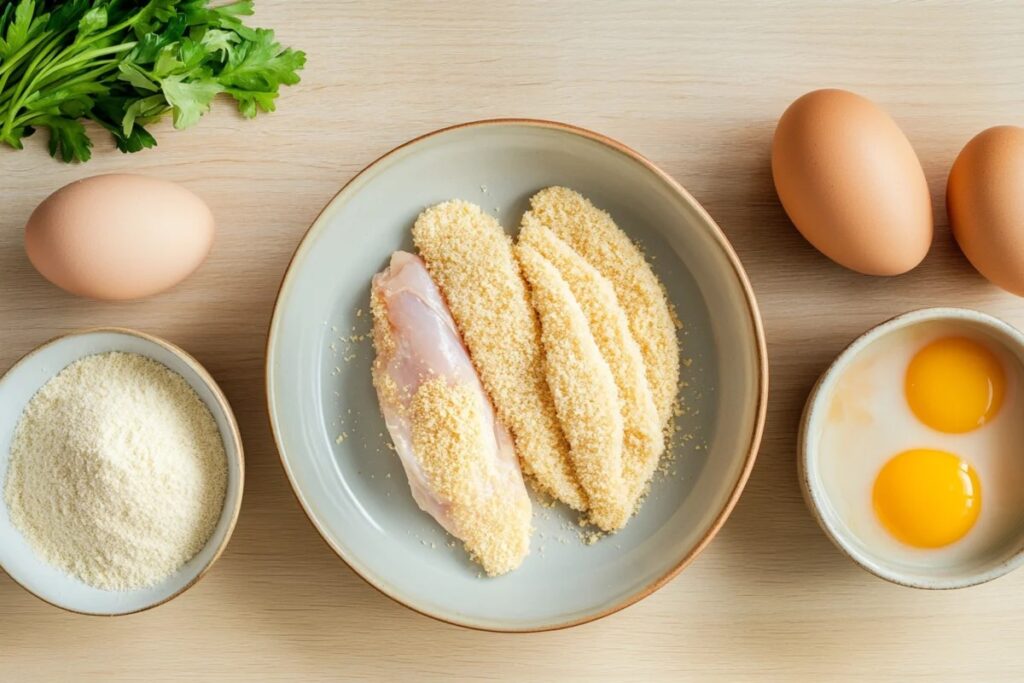When you crave that perfect crunch, nothing compares to the satisfying bite of a well-prepared piece. Eventually, achieving this ideal texture depends on various factors, including the choice of ingredients, cooking methods, and careful preparation. Indeed, focusing on crispness can transform a simple dinner into something unforgettable. Furthermore, by understanding the science behind that sought-after exterior, you can create a dish that pleases even the most discerning palates. In this comprehensive guide, we will explore everything from selecting cuts and coatings to choosing cooking techniques and serving suggestions. Consequently, by the end, you will feel confident about producing results that rival your favorite restaurant.

Crispy Chicken: Perfect Crunch Every Time
Crispy chicken with a crunchy coating and juicy interior, made with a three-step breading technique and fried to golden perfection.
- Total Time: 35 minutes
- Yield: 4 servings 1x
Ingredients
2 lbs chicken pieces (thighs, drumsticks, wings)
1 cup flour
1/2 cup cornstarch
2 tsp salt
1 tsp black pepper
1 tsp paprika
1/2 tsp garlic powder
2 eggs, beaten
1 cup buttermilk
Oil for frying
Instructions
1. Season chicken and let sit 10 mins.
2. Dredge in flour-cornstarch mixture.
3. Dip into beaten eggs and buttermilk.
4. Coat again in seasoned flour.
5. Fry in 350°F oil for 7-8 mins per side.
6. Drain on paper towels and serve.
Notes
Use a thermometer to ensure oil stays at 350°F.
Let chicken rest before serving for juicier results.
- Prep Time: 15 minutes
- Cook Time: 20 minutes
- Category: Main Dish
- Method: Frying
- Cuisine: American
Nutrition
- Serving Size: 1 piece
- Calories: 350
- Sugar: 1g
- Sodium: 800mg
- Fat: 20g
- Saturated Fat: 4g
- Unsaturated Fat: 14g
- Trans Fat: 0g
- Carbohydrates: 18g
- Fiber: 1g
- Protein: 25g
- Cholesterol: 95mg
Why Crispy Chicken Has Captured Our Hearts
Many people ask why crispy chicken remains so popular. Initially, this dish resonates with those who appreciate contrasting textures. Basically, the crisp exterior and juicy interior create a delightful eating experience. Moreover, crispy chicken offers nostalgia and comfort, recalling family gatherings, weekend dinners, and special occasions. Conversely, it also adapts well to modern tastes, welcoming spicy rubs, international seasonings, and healthier cooking methods.
The Sensory Appeal of Crispy Chicken
Undoubtedly, the allure of crispy chicken stems from the sensory pleasures it provides. Comparatively, few foods combine tenderness and crunch as well. Specifically, the sound of that first bite is appealing. Furthermore, the aroma of well-seasoned breading intensifies the anticipation. Eventually, the harmonious marriage of taste, texture, and smell explains why crispy chicken never goes out of style.
Cultural and Culinary Influences
While the concept of crispy chicken might seem universal, each culture adds its own spin. For instance, Southern American fried chicken leans on buttermilk and a seasoned flour coating. Meanwhile, Japanese karaage involves marinating bite-sized pieces and frying them until crisp. Equally, Korean fried chicken uses double frying to achieve an ultra-crunchy shell. Thus, exploring different culinary traditions can inspire your own cooking approach and encourage experimentation.
Mastering the Coating for Crispy Chicken

To achieve crispy chicken, focusing on the coating is vital. Initially, consider the ingredients you choose. Flour, cornstarch, or a mixture of both can impact the final crunch. In addition, adding spices, dried herbs, or even grated Parmesan can elevate flavor. Eventually, the perfect coating should cling tightly to the chicken and remain crisp after cooking.
Creating a Flavorful Base
Essentially, seasoning the chicken before coating adds depth. Accordingly, salt and pepper are basic but essential. Additionally, incorporating garlic powder, onion powder, paprika, or cayenne can create complexity. Meanwhile, dried herbs like oregano, thyme, or rosemary bring aromatic notes. Afterward, a short marination time helps the seasonings penetrate, ensuring more flavorful bites.
The Role of Breading Techniques
When making crispy chicken, consider how you apply the breading. Generally, a three-step process works best:
- Dredge in flour or cornstarch.
- Dip in beaten eggs or buttermilk.
- Coat in seasoned crumbs or a flour-cornstarch mixture.
Likewise, pressing the coating onto the chicken ensures it adheres better. Comparatively, using panko breadcrumbs can result in a lighter, crunchier crust. Moreover, double-dipping—flour, liquid, then flour again—can produce an even crunchier shell.
Easy Techniques for Achieving Crispy Chicken at Home

Many home cooks wonder if restaurant-quality crispy chicken is achievable in their own kitchens. Luckily, it is. Indeed, understanding a few simple techniques can make all the difference. For example, choosing the right oil, frying at the correct temperature, and allowing the chicken to rest afterward can optimize results.
Choosing the Right Cut for Crispy Chicken
Initially, selecting the appropriate cut influences the final texture. While bone-in thighs and drumsticks provide richness, boneless breasts offer leaner bites. Conversely, chicken wings deliver snackable portions perfect for game days. Meanwhile, tenders ensure easy, kid-friendly meals. Thus, your choice of cut depends on personal preference and desired meal style.
Temperature Control for Perfect Crispy Chicken
Controlling heat is crucial. Essentially, an oil temperature of about 350°F (177°C) suits many fried chicken recipes. However, ensuring the oil temperature remains consistent is key. If it drops too low, the chicken absorbs excess grease, leading to a soggy crust. Conversely, if it’s too high, the coating may burn before the meat cooks through. Thus, monitoring oil temperature with a thermometer ensures a crisp, evenly cooked result.
Serving Suggestions to Highlight Crispy Chicken
Once you achieve the perfect crispy chicken, consider what to serve alongside it. A simple coleslaw offers cool contrast, while mashed potatoes deliver creamy comfort. Consequently, fresh green salads lighten the meal. Additionally, adding a dipping sauce—like spicy aioli, honey mustard, or barbecue sauce—enhances flavors. Finally, bread and pickles can add even more dimension to your plate.
Exploring Variations of Crispy Chicken
While classic fried chicken remains iconic, other variations exist. Indeed, baking or air frying can yield similarly crispy chicken while reducing oil. Eventually, experimenting with international seasonings or spice blends keeps things interesting.
Baked and Oven-Fried Methods
For those who prefer less oil, baking offers a healthy alternative. Initially, lightly coat your chicken with seasoned crumbs, then spray with cooking oil. Afterward, bake at a high temperature until the exterior turns crisp. Meanwhile, oven-fried methods use a wire rack to promote air circulation around the chicken. Consequently, the result is crispy, without the heaviness of deep-frying.
Air Frying for Crispy Chicken
Air fryers have become popular for delivering crispness with minimal oil. Basically, they circulate hot air around the food, ensuring even browning. Equally, they’re efficient and user-friendly. Moreover, air frying suits smaller portions and requires less cleanup. Eventually, you’ll find air-fried crispy chicken a convenient weeknight solution.
Global Flavors and Innovative Twists
To keep your taste buds excited, season your crispy chicken with exotic flavors. For example, try adding Indian spices like garam masala or cumin for a warm, fragrant twist. Meanwhile, use a Korean-style glaze made from gochujang and honey for sweet heat. Furthermore, consider a Mediterranean herb mix for bright, herbal notes. Incorporating these variations elevates your crispy chicken to gourmet status.
Balancing Texture and Moisture in Crispy Chicken
Achieving crispness without drying out the meat can be challenging. Nonetheless, with the right approach, you can enjoy juicy results beneath a crunchy exterior. Initially, brining or marinating infuses moisture. Additionally, a brief soak in salted water tenderizes and seasons from within. Conversely, buttermilk marinades help ensure each bite remains moist and flavorful.
Ensuring Juiciness Under the Crust
To maintain juiciness, avoid overcooking. Indeed, a meat thermometer helps ensure the internal temperature reaches 165°F (74°C) without overshooting. Moreover, resting the chicken briefly after cooking allows the juices to redistribute. Consequently, you’ll enjoy succulent, savory bites under that perfect crispy exterior.
Avoiding Common Pitfalls
Sometimes, achieving crispy chicken requires troubleshooting. For instance, if your chicken turns out greasy, you might have fried at too low a temperature. If the coating falls off, you may have skipped the proper breading steps or handled the chicken too roughly. Additionally, if the crust lacks flavor, you might need more seasoning in your dredge. By identifying issues, you can refine your technique and improve results over time.
Healthier Approaches to Crispy Chicken
While traditional frying uses oil, you can still enjoy crispy chicken without excessive fat. Eventually, consider shallow frying in less oil or using healthier oils like avocado or olive oil. Consequently, you reduce calories while maintaining crunch. Indeed, trimming visible fat and removing the skin before breading also helps.
Using Whole Grains and Alternative Flours
For a healthier twist, experiment with whole-grain flour or almond flour. These alternatives add nutrients and fiber while still contributing crispness. Similarly, crushed cereal flakes or quinoa flakes can provide interesting textures. By incorporating these ingredients, you enhance both nutrition and complexity.
Pairing With Nutritious Sides
Balancing your meal with wholesome sides can make indulgent crispy chicken feel lighter. Consider roasted vegetables, such as Brussels sprouts or sweet potatoes. Additionally, a simple green salad with a light vinaigrette complements the richness of fried chicken. Eventually, these sides help create a well-rounded plate that satisfies both cravings and health goals.
Entertaining with Crispy Chicken
This dish is perfect for entertaining. Because it’s so widely enjoyed, it naturally brings people together. For instance, serve sliders with small, crunchy bites, pickles, and tangy sauce at a party. Meanwhile, a large platter of seasoned wings ensures everyone can share. Altogether, presenting food in bite-sized portions encourages guests to mingle and savor the experience.
Themed Meals and Pairings
Another way to impress guests is to build a themed meal around crispy chicken. For example, pair Southern-style chicken with cornbread, collard greens, and sweet tea. Conversely, combine Asian-inspired crispy chicken with kimchi, pickled vegetables, and rice. Undoubtedly, these thoughtful menu choices elevate the dining experience.
Leftovers and Meal Prep
If you have leftover crispy chicken, don’t let it go to waste. Consequently, you can slice it and top salads or wrap it in tortillas for easy lunches. Similarly, reheating in the oven or air fryer revives some crunch. Furthermore, consider storing leftover chicken in airtight containers to preserve freshness. This approach reduces waste while providing quick, flavorful meals throughout the week.
Crispy Chicken for Every Occasion
Crispy chicken fits seamlessly into countless situations. It works as a simple family dinner, a weekend treat, a picnic favorite, or a holiday feast component. By adjusting seasonings and cooking methods, you tailor it to any event. For example, serve mild crispy chicken strips for kids’ parties or spicy Korean wings at a movie night with friends. Consequently, adaptability is one of the dish’s greatest strengths.
Personalizing Your Meals
Your preferences matter. Perhaps you like extra heat or prefer a delicate crunch. Accordingly, modify recipes to match your taste. Eventually, your personalized version of crispy chicken becomes a signature dish that everyone anticipates.
Staying Inspired
Finally, remember that cooking is an ongoing journey. Over time, you will refine your technique and discover new favorites. Keep learning, tasting, and experimenting. As you gain experience, crispy chicken becomes more than just a dish—it becomes part of your culinary identity.
for more recipes follow our facebook page
Conclusion: Perfecting Crispy Chicken for a Memorable Meal
In conclusion, achieving the ultimate crispy chicken experience involves understanding fundamentals and embracing creativity. Certainly, proper seasoning, careful coating, correct cooking techniques, and thoughtful serving ideas lead to outstanding results. Eventually, mastering crispy chicken means delighting in the contrast of textures, enjoying the interplay of flavors, and savoring the satisfaction of a job well done. Therefore, explore various methods, ingredients, and presentations. Undoubtedly, with practice, you can consistently produce crispy chicken that impresses family, friends, and guests. Enjoy the journey, and keep refining until you reach that perfect crunch every time.
FAQS
What is the secret to crispy chicken?
The secret involves selecting the right coating, keeping the oil at a steady temperature, and using proper seasoning. Also, patting the pieces dry before breading ensures maximum crunch. Finally, avoid overcrowding the pan to allow even cooking and prevent any soggy spots.
What makes chicken crispier flour or cornstarch?
Cornstarch generally produces a lighter, crunchier exterior. Meanwhile, flour creates a sturdier crust. Combining both often yields the best results, balancing structure and crispness.
Is baking powder or cornstarch better for crispy chicken?
Baking powder can add crispness by creating bubbles in the batter. Cornstarch, however, is more common for promoting a delicate crunch. Often, a blend of baking powder and cornstarch provides exceptional crispiness.
What is the difference between crispy and crunchy chicken?
Crispy chicken has a delicate, thin crust that shatters easily under pressure. Crunchy chicken, conversely, may have a thicker coating and a more substantial bite. Both are enjoyable, but crispy textures often feel lighter, while crunchy ones offer a denser, more robust mouthfeel.

1 thought on “Crispy Chicken: Perfect Crunch Every Time”